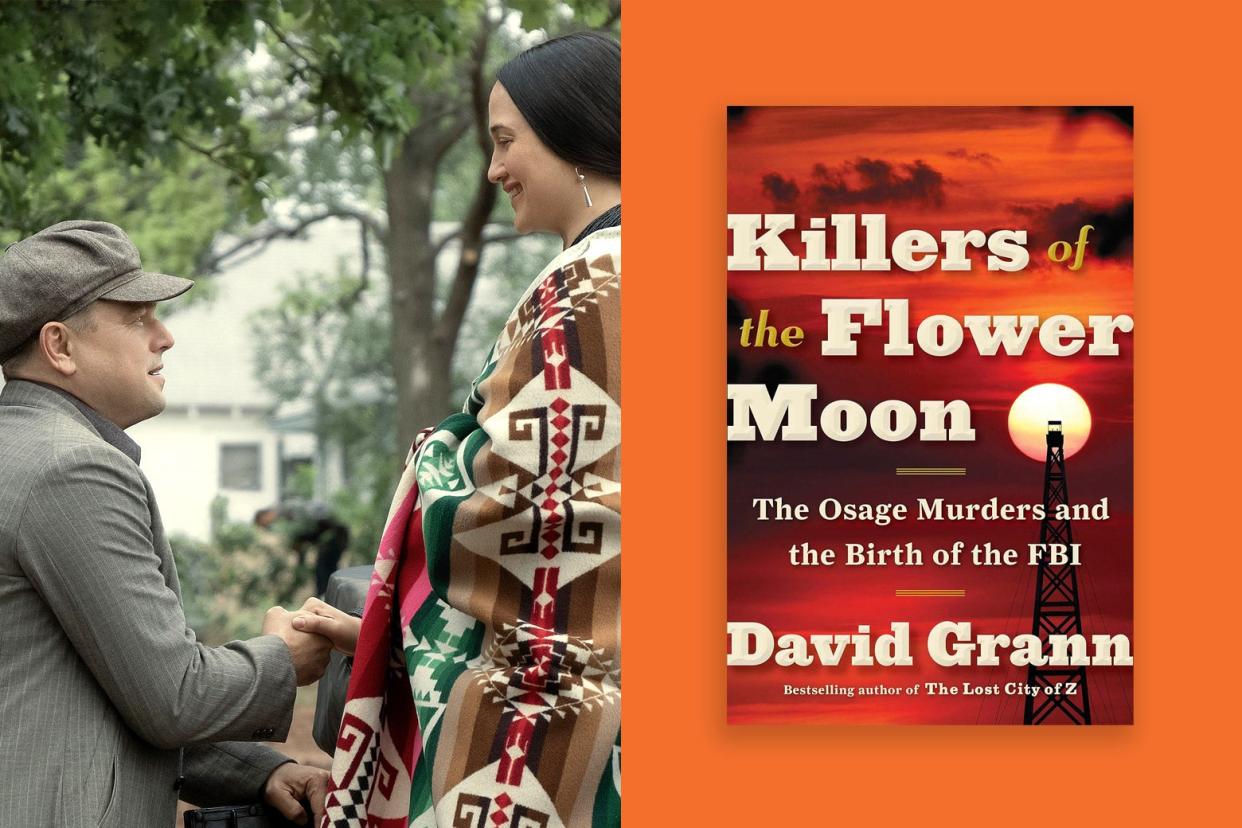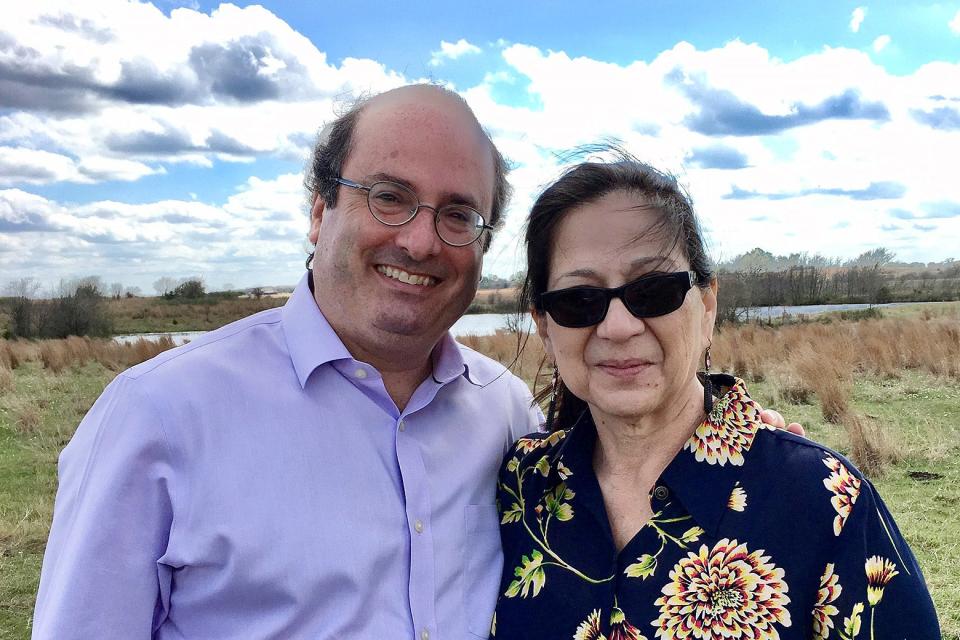Killers of the Flower Moon ’s Author on the Changes the Movie Makes to the Book

- Oops!Something went wrong.Please try again later.
Martin Scorsese’s career-capping Killers of the Flower Moon likely never would have happened without David Grann, the New Yorker writer with a preternatural knack for unearthing astonishing, dramatic stories from history. But in the journey from book to film, Scorsese and Eric Roth’s script underwent dramatic changes—including a major shift in focus from an FBI investigation to the Osage of 1920s Oklahoma and the white prospectors and landowners who exploited them. I talked to Grann about Scorsese’s willingness to dig into history, about a white writer telling a Native story, and about the unusual undercover team the FBI’s Tom White assembled to begin to crack the Osage killings. Our conversation has been edited and condensed for clarity.
Dan Kois: What’s it like to get that phone call and hear that Martin fuckin’ Scorsese wants to turn your book into a movie?
David Grann: I spend all my time working with archival material and interviewing people. So, when somebody calls you and says, “Yes, the greatest living director wants to develop this history,” you’re back to being that person who sits in a theater, just watching these films as you grew up. You suddenly remember Taxi Driver and Goodfellas. You’re blown away.
How did you view this story fitting in that Scorsese canon?
The exploration of greed and exploitation—the criminal hierarchies, because there is a real criminal world—it’s very different than the world he’s explored, and the landscapes are very different, but he’s still exposing some of those insidious sins that lie at the heart, unfortunately, of the human condition.
You’re always nervous as a writer when somebody is going to adapt a work of history, and especially when it’s a work of history that is so serious. This is really about one of the more monstrous crimes and racial injustices in American history. For me, the thing that really struck me was less the parallels with Scorsese’s previous work, but his commitment to this history, and to getting it right. They were going to approach it in their own medium, but they shared that commitment.
I keep thinking about that New York Times Magazine profile of production designer Jack Fisk, which betrays an almost crazed interest in making sure the history is right.
To me, it actually made this experience almost familiar, because at times it just felt like so many little historians who were trying to dig in, and to learn everything they can. I don’t get that involved in the filmmaking business. I don’t know anything about filmmaking, and I don’t aspire to be a screenwriter. It’s not something I’ve ever wanted to do. My role is really to be there as a resource when they need me. But they were just obsessive, and they did a lot of their own research. I do remember, once, they called me and they said, “We’re trying to figure out the lighting in Mollie Burkhart’s house.” And I said, “Well, I know she had lighting, but … that’s something I don’t know. You’re on your own on that one.”
I was just rereading one of the scenes in Mollie’s house, and there’s a bunch of stuff on smell but nothing on the lights.
One of the reasons I began the book with that opening scene, with Mollie in her house, was because there were so many underlying documents. I had multiple interviews from so many different investigators, and so you could reconstruct it so well, with such detail. But the one detail I did not think about was the exact lighting in the house.
How does Marty communicate? Was it all through intermediaries and assistants, or were you getting voice memos from Marty at 2 in the morning?
I was not. I had some conversations with him, but it was limited, early on when he was taking on the project. He had a wonderful producer who really deserves an enormous amount of credit for the depth of research in the film. Her name was Marianne Bower, and she was my primary contact, because she was doing so much of the historical research.
The screenplay took a hard left turn during development. Once, it really followed Tom White, the FBI agent, through his investigation, and had the whodunit structure of the book. But at some point that changed, and the version that’s on screen isn’t a whodunit. We know pretty early on that we are watching the perpetrators. And the story is framed through the Osage and their experience of this. Did you know about this change when it happened, and what did you think about it?
The book is really this sweeping history. It goes all the way back to when the Osage laid claim to much of the central part of the country. And it’s told in a kind of triptych: The first chronicle was told from the point of view of Mollie Burkhart. And the second part of the book is told from the perspective of Tom White. And then the third is told from the present, and shows that there really was this much deeper and darker conspiracy that the bureau never exposed. And in that section I interview the descendants of so many of the Osage victims, including a descendant of Mollie Burkhart, Margie. I never saw the first script, but they really were just doing the second part of the book, it sounded like. And then eventually DiCaprio called me—he was supposed to play Tom White—and he said they were going to shift the focus, and what did I think? And I said, “Oh, I 100 percent would do that.” I thought it was a smart thing to do. It’s more faithful, actually, to the history in the book.

The movie has this whole collection of Osage and native consultants to help them feel as though they’re getting it right. As you were researching and writing, how did you think about being a white guy telling the story, and how did you help yourself feel confident that you were getting it right and that you had the right to tell it?
Whatever you’re writing about, you’re so conscious that you’re an outsider. To any story you write about. I approached the Osage elders. I was transparent about what I was trying to do. And I spent many, many years spending time in the community, over more than half a decade, getting to know them, having them share their stories and trust me with their stories. If you’re not worried about getting things right, then you should be doing something else. So I’m always worried.
The one thing I asked of the publisher when the book came out was that they send me back to these small towns so I can present my research. So many members of the Nation came, and I spent all day with them just speaking about the book. And then that evening they invited me up to Gray Horse, up to the community house, and all the elders were there. And they presented me with a blanket. I don’t think I’ll ever have an experience like it again.
I think that people who see the movie are going to have the same sense that you did, that this revised structure deepens our connection to the people in the movie, to the story of the movie, to the Osage Nation. But it also means that some of those stories of the FBI guys don’t get told as thoroughly as they do in the book. And there is this whole fun subplot of this unusual team of investigators that White assembles for this long investigation into the murders, including an insurance salesman and guys posing as cattlemen. Who were all these guys?
The bureau’s early investigation of these crimes was plagued by many of the same problems that plagued law enforcement across the country at the time: inexperience, ineptitude, prejudice. J. Edgar Hoover turns to Tom White, one of these old frontier lawmen, who puts together an undercover team. They too were frontier lawmen, and most interestingly, one of them was an American Indian, John Wren. We don’t know the precise number of American Indians who might’ve been on the rolls at that time, but given Hoover’s prejudice, it’s probably fair to assume he was the only one. And they went in undercover, posing as cattlemen, and one posed as an insurance salesman. And according to the record, he sold actual policies, which I know is slightly bewildering. And ultimately what they did is they followed the money, and in particular, who was profiting from the murders of Mollie Burkhart’s family. And of course it would lead them to somebody whom she loved and whom she thought had loved her, and whom she thought she could trust.
But although the bureau was able to capture a few of these killers, there really was this much deeper and darker conspiracy that the bureau never exposed. And when I met with so many of those Osage elders, they began to tell me about these other killings in their families that had never been properly investigated. Over time, I realized that this was a story about this culture of killing, about these many people who were committing these crimes—about doctors who were ministering poisons, morticians who were covering up bullet wounds, businessmen and lawmen who were complicit in their silence. All because they were getting wealthy from what they referred to openly as “the Indian business.” It’s much easier for us to think of it as just a singular evil figure, which, if we remove that figure from our community, everything is OK. But what if these crimes are being committed by ordinary and seemingly respectable people?
Just to go back, you asked me earlier about the shift in focus. I remember speaking to DiCaprio when he said he wanted to shift from playing Tom White to Ernest Burkhart. My reaction was, “I would do it if I were you.” Because while White is a fascinating figure, Ernest gets at the very nature of these crimes, because Ernest represents the way that these seemingly ordinary people who had a conscience, who weren’t sociopaths, went along with these crimes, with an increasing level of complicity.
People who maybe even love their wives by the standards of their day, but who nonetheless were completely willing to go along with this system.
You can’t understand the Osage reign of terror without understanding those people.
Last question: Is it true that now Scorsese is making The Wager?
Well, look, after seeing this film, when he and DiCaprio’s folks reached out and said they were interested in developing The Wager, it was the easiest decision I ever had to make.
Congratulations on being one of Marty’s guys.
Thank you.

